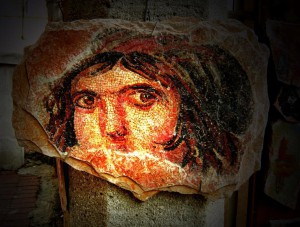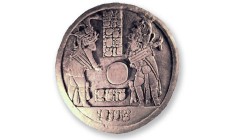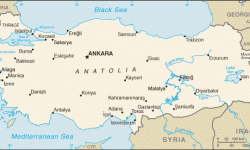Zeugma Mosaics

The ancient site of Zeugma in Turkey, now partially inundated by a dam, has experienced extensive looting, particuarly for its fine mosaics.
Zeugma comprises the two ancient cities of Seleucia and Apameia sitting on opposite banks of the Euphrates in Turkey, connected by a bridge, hence ‘zeugma’ from the ancient Greek for ‘junction’ or ‘bridge’ (Shoup 2006: 234). Belkis and Tilmuse, the modern settlements, were known to have ancient ruins for many years, but it was not until the 1970s that it was recognised for certain that these remains were actually Zeugma (Kennedy et al. 1998: 7). Zeugma was occupied from around 300 BC, in its heyday growing to a population of some 70,000, with growing prosperity leading to a taste for frescoes and fine mosaics in many of the villas of Zeugma’s inhabitants (Acar 2000a; 2000b: 40-41). Economic decline, a series of attacks, and earthquakes led to the apparent abandonment of the settlement by the 11th Century AD, with no further mention of it after 1048 (Acar 2000b: 41).
It is believed that looting has taken place at Zeugma since at least the 19th Century (Acar 2000b: 42), with one example of a looted mosaic known from 1873 (Kennedy et al. 1998: 129). There are forty-one pieces at least of this particular mosaic, known as the ‘Provinces’ mosaic, ‘located in 11 public and private collections in 7 countries’ (Kennedy et al. 1998: 129). Other materials from Zeugma, including statuary, portable antiquities and of course mosaics, are believed to be ‘scattered over 40 collections both inside and outside Turkey’ (Gates 1995: 249). It has been noted that objects listed in catalogues and collections with obscure provenances, under such terms as ‘Aintab’, ‘Upper Euphrates region’, (Kennedy et al. 1998: 129), ‘East Mediterranean’, ‘near Syria’, ‘said to be from East Turkey’, ‘possibly from South East Anatolia’, or in one case in a museum in North Carolina ‘Roman, probably from East Turkey’ (Acar 2000b: 42) could feasibly, sometimes probably, have been looted from Zeugma (and see Kennedy et al. 1995).
Adding to the long term looting threats facing Zeugma, an environmental challenge was introduced with the South East Anatolia Project (Güneydogῠ Anadolu Projesi – GAP) (Shoup 2006: 232). GAP:
‘…is a multi-sector and integrated regional development effort approached in the context of sustainable development. Its basic objectives include the improvement of living standards and income levels of people so as to eliminate regional development disparities and contributing to such national goals as social stability and economic growth by enhancing productivity and employment opportunities in the rural sector.’
(GAP 2011a)
This development project has constructed numerous dams and hydro-electric plants in the region, including at the site of Zeugma, which was partially flooded in 2000 amid the 100 square kilometers of arid land inundated by the Birecik Dam, dispersing local residents and damaging other archaeological remains (Cherry 2011: 14-15). Although the damming of the area, and associated debates concerning economic development, cultural heritage protection and sustainable energy appear seperate issues to that of looting (and see Shoup 2006 for an analysis), it was noted by Kennedy et al. (1998: 7, 247) that awareness of the imminent construction of the dam had likely accellerated the rate of looting in the area.
Another side-effect of the Birecik Dam’s construction was the need for hasty ‘rescue’ investigation to ensure that as much of the site as possible was recorded archaeologically before it was too late (Gates 1995: 207). The extensive publicity given to Zeugma’s plight has been credited with securing significant funding for investigations conducted prior to the flooding of the site (Greaves and Helwing 2001: 463). In the 1990s through to 2000, various excavations took place, including a project in 2000 funded by the Packard Humanities Institute (Early et al. 2003: 9). The rescue excavation reports, particularly in two Journal of Roman Archaeology Supplementary Series volumes (Early et al. 2003; Kennedy et al. 1998), noted the presence of looting. This ranged from simply not knowing whether looting had occurred or not, thus affecting the data being collected (Early et al. 2003: 43), through to using the evidence of previous looting, such as tunnels and pits, as a means of indicating ‘clues as to the depth and nature of the overburden and nature of the ancient remains at various points’ (Kennedy et al. 1998: 61).
The discovery in 1993 of a partially-looted mosaic floor led to the repatriation of ‘trafficked’ sections of the same floor back to the nearby Gaziantep Museum from the private Menil Collection in Houston, Texas (GAP 2011b; and see Kennedy et al. 1998: 109-28). These pieces had been on loan at the time to Rice University, also in Texas (Eisenberg 1999). Other recent calls for repatriation have included mosaics from Bowling Green State University in Ohio, with the university quickly going public about the situation after the mosaics in their possession were identified as probably looted in January 2012 (Litt 2012).
The Gaziantep Museum houses many of the finds from Zeugma, including repatriated objects and also objects damaged by looting. For example, edges of a mosaic recovered in rescue excavations were found to match a central panel comprising the two pieces in the Menil Collection mentioned above, that had been removed by looters (see Kennedy et al. 1998: 121-23).
While the site itself is now partially submerged due to the dam, with much of the surrounding area also inundated, it is likely that calls for repatriation will continue for pieces attributable to Zeugma, especially given the current disposition of the Turkish authorities actively to pursue cultural objects in museums and collections overseas that they believe to have been removed illegally from Turkey (The Economist Newspaper 2012).
See also the images of the Metiokhos and Parthenope mosaic during excavation in 1993. These can be seen in the Data section.
References
Acar, Ozgen (2000a), ‘Mosaics and heads of statues plundered from Zeugma’, Culture Without Context, 7, 5-8.
— (2000b), ‘Troubled Waters’, Archaeology, September/October 2000, 40-43.
Cherry, John (2011), ‘Still not digging, much’, Archaeological Dialogues, 18 (1), 10-17.
Early, Robert, et al. (2003), Zeugma: Interim Reports, ed. J.H. Humphrey (Journal of Roman Archaeology Supplementary Series, 51; Portsmouth, RI: Journal of Roman Archaeology).
Eisenberg, Jerome (1999), ‘Roman mosaics stolen from Zeugma on the Euphrates’, Minerva, 10 (3), 5.
GAP (2011a), ‘What is GAP’, http://www.gap.gov.tr/about-gap/what-is-gap, accessed 30/05/2012.
— (2011b), ‘The Importance of Cultural Heritege in GAP and Zeugma’, GAP http://www.gap.gov.tr/projects-and-activities/belkis-zeugma/the-importance-of-cultural-heritage-in-gap-and-zeugma, accessed 30/05/2012.
Gates, Marie-Henriette (1995), ‘Archaeology in Turkey’, American Journal of Archaeology, 99 (2), 207-55.
Greaves, Alan M. and Helwing, Barbara (2001), ‘Archaeology in Turkey: The Stone, Bronze and Iron Ages, 1997-1999’, American Journal of Archaeology, 105 (3), 463-511.
Kennedy, David, Ergec, Rifat, and Freeman, Philip (1995), ‘Mining the Mosaics of Roman Zeugma’, Archaeology, 54 (2), 54-55.
Kennedy, David, et al. (1998), The Twin Towns of Zeugma on the Euphrates: Rescue Work and Historical Studies, ed. J.H. Humphrey (Journal of Roman Archaeology Supplementary Series, 27; Portsmouth, RI: Journal of Roman Archaeology).
Litt, Steven (2012), ‘Turkey wants Bowling Green State University’s ancient Roman mosaics returned’, (updated 06/03/2012) http://www.cleveland.com/arts/index.ssf/2012/03/turkey_wants_bgsus_ancient_rom.html, accessed 12/04/2012.
Shoup, Daniel (2006), ‘Can Archaeology Build a Dam? Sites and Politics in Turkey’s Southeast Anatolia Project’, Journal of Mediterranean Archaeology, 19 (2), 231-58.
The Economist Newspaper (2012), ‘Of marbles and men: Turkey gets tough with foreign museums and launches a new culture war’, The Economist Newspaper (updated 19/05/2012) http://www.economist.com/node/21555531/print, accessed 25/05/2012.




